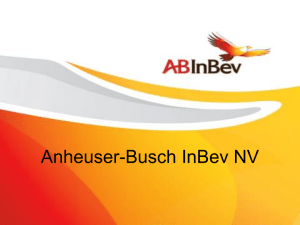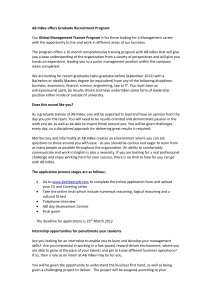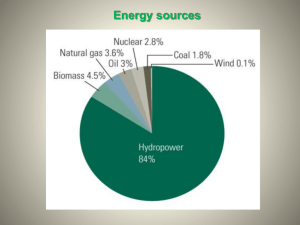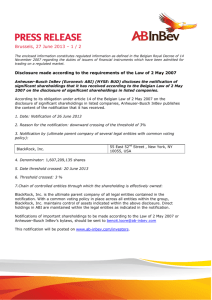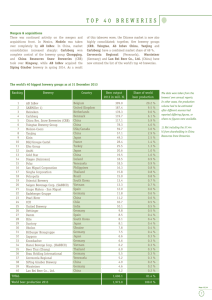AB Inbev - WordPress.com
advertisement
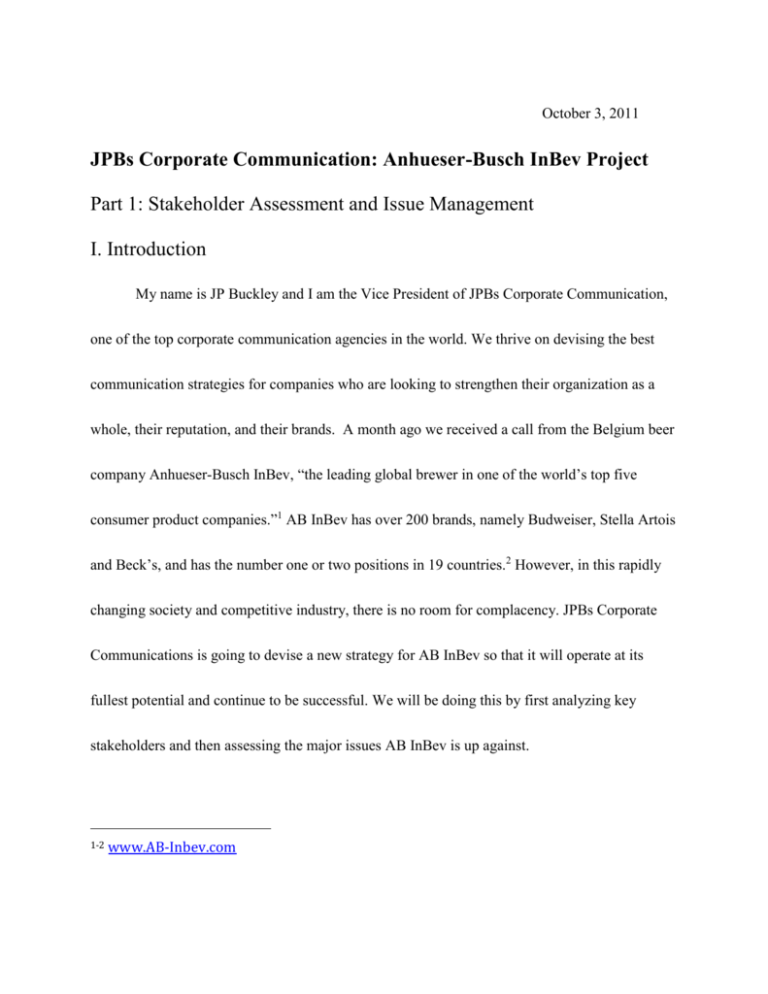
October 3, 2011 JPBs Corporate Communication: Anhueser-Busch InBev Project Part 1: Stakeholder Assessment and Issue Management I. Introduction My name is JP Buckley and I am the Vice President of JPBs Corporate Communication, one of the top corporate communication agencies in the world. We thrive on devising the best communication strategies for companies who are looking to strengthen their organization as a whole, their reputation, and their brands. A month ago we received a call from the Belgium beer company Anhueser-Busch InBev, “the leading global brewer in one of the world’s top five consumer product companies.”1 AB InBev has over 200 brands, namely Budweiser, Stella Artois and Beck’s, and has the number one or two positions in 19 countries.2 However, in this rapidly changing society and competitive industry, there is no room for complacency. JPBs Corporate Communications is going to devise a new strategy for AB InBev so that it will operate at its fullest potential and continue to be successful. We will be doing this by first analyzing key stakeholders and then assessing the major issues AB InBev is up against. 1-2 www.AB-Inbev.com II. Key Stakeholder Identification At JPBs Corporate Communications, we understand the value and influence that stakeholder groups have. With a company of this size and worth, especially since the merger with American brewery Anheuser-Busch in 2008, there are many different stakeholder groups. From consumers to non-governmental organizations and everything in between, every group is recognized and treated with the utmost consideration and respect. However, when planning corporate communication strategy, some stakeholder groups outweigh others in terms of importance to a company. The following is the top five stakeholder groups for AB InBev. The number one stakeholder group to Anhueser-Busch InBev is the consumers. Obviously, AB InBev would not exist without them because there would be no beer industry at all. They are the first and foremost priority when developing any new corporate strategy because the company needs them in order to grow and be successful. In the beer industry, there are always new potential consumers to be reached. Thus, it is crucial to future growth and stability that AB InBev develops trusting mutual relationships with its consumers. The second most important stakeholder group is the customers that AB InBev distributes its products to. These include supermarkets, hypermarkets, bars, and locations where any InBev product is sold. This group is extremely important to the success of the company because they are responsible for getting the product to the consumers. Because AB InBev is such a large company with locations all over the world, it relies heavily on continued business from its customers to get the 200 brands of beer in the hands of its consumers. Without the customers functioning as the middleman, the company would not continue to function. The employees at AB InBev, over 114,000 men and women in 23 countries3, are the third most important stakeholder group because a company is only as strong as its workforce. They are the people who allow the company to operate and function. From the bottom of the corporate ladder to the top, each and every employee is absolutely vital for success. The size of this stakeholder group alone makes them very important to AB InBev. In devising strategy to get the company operating at its full potential, the interests of the entire employee workforce must be taken into consideration. AB InBev is a publically traded fortune 500 company that realized a 36.6 billion US dollar revenue in 2010 with an 84.46 billion US dollar market cap in the New York Stock Exchange.4 In a company of this financial magnitude, investors become a high priority stakeholder group. An entire branch at AB InBev, dedicated to investor relations, keeps investors informed and satisfied with the company’s performance. Because these investors own portions www.AB-Inbev.com 4 Yahoo Finance 3 of this company and their investments are crucial, management strategies on company matters must always be in line with their investors best interests. The final stakeholder group that we have ranked does not hold as much weight to AB InBev as the previous four, but it is gaining more and more importance and deserves to be mentioned. If AB InBev wants to make the best beer, they are going to need the best ingredients. Obtaining these ingredients were never a problem in the past; however, studies show that climate change is having a major affect on the yield and quality of hops5, a main ingredient in beer. While this is not an immediate threat, nor do suppliers have major influence on company strategy, AB InBev must realize that changing environmental conditions is going to bring supplier relationships to the forefront. To conclude, consumers, customers, employees, investors, and suppliers are the current key stakeholders for the Anhueser-Busch InBev beer company. AB InBev relies on these groups to make it “The Best Beer Company in a Better World.” Without one of these, the company would cease to exist. ScienceDirect.com The impact of climate change on the yield and quality of Saaz hops in the Czech Republic 5 III. Materiality Chart Marketing Practices Charity/Volunteerism Public Policy Corporate Governance Diversity Philanthropy Employee Training Employee Satisfaction Health and Saftey Advancement Supply Chain Finance IV. Issues Management The issues listed in the top right of the AB InBev materiality chart are the focus of this section. These issues present an immediate threat to the company and its key stakeholders, and thus need to be addressed. The first issue is shown in the statistic that industry beer sales have been steadily dropping over the past ten years. Last year in 2010, beer sales declined 1.5% in America and 2.3% in Western Europe.6 Further, Budweiser, the flagship brand for AB InBev, has dropped 30% in sales from 2006-2010.7 This trend is likely to continue, as today’s society is becoming more health conscious. People are moving away from the heavy calorie beers toward light beers, especially craft brews such as Blue Moon. Moreover, an article in The Economist said that wealthy people prefer wine and hard liquor, and will likely choose a special craft brew if they want to drink beer. AB InBev has already been forced to shut down a few breweries in Belgium due to lack of sales, causing unrest amongst consumers, customers, and employees.8 This is a major issue that needs to be handled. Beer sales falling in the western countries of the world only makes emerging markets in eastern countries, specifically China, all the more important. China is the world’s largest market The Economist- Sell foam like soap May 5, 2011 7 Traditional beer sales down, craft brews up by Lauren Lang September 18, 2011 8 The Telegraph- Beer supplies to run dry amid Belgium brewery protests Jan 13, 2010 6 and AB InBev has a great opportunity to move from the third position in the China beer industry, to the first, currently occupied by CP Snow.9 Although sales have largely increased by 9.8% in China, AB InBev only has 11% market share.10 New markets will help AB InBev create more jobs for people as well as increase revenue, which will make investors happy. The only way for AB InBev to take control of these emerging markets is to build more plants in these countries. While job opportunities and increased revenue is positive, more plants mean more environmental damage from energy waste to green house gas emissions. Production plants use a tremendous amount of energy to complete the process, mainly in the form of electricity. Moreover, carbon dioxide is released into the atmosphere during the fermentation process. AB InBev has made great strides in cutting down CO2e emissions per hectoliter of production by 3%, but 4.35million metric tons were released in 2010.11 By-product and material waste from plants also add to AB InBev’s large ecological footprint. While these issues are inevitable in this industry, and AB InBev has set reduction goals, these are prevalent issues that impact the environment and all living things. More plants also bring more water use, which is one of the biggest issues in the beer industry. Water managers are predicting two-thirds of the world population will face water China Daily AB InBev deal may reshuffle Chinese market 10 Buisness China- AB InBev builds first Southwestern China plant in Sichuan. May 30, 2011 11 AB InBev 2010 Global Citizenship Report 9 scarcity by 2025 and 36 states in the US will have water shortages as soon as 2013.12 With 90% of beer being water13, and it taking about 20 gallons of water to make one pint of beer14, it is clear that water usage is a major issue given the current water situation on earth. AB InBev has shown improvement by cutting its water usage from 5.05 hectoliters per hectoliter of production in 2007 to 4.04 hl/hl15. Again, water usage in large quantities is inevitable in the beer industry, but AB InBev has a responsibility as a global corporation to work at limiting water waste and testing new sustainable methods. As briefly mentioned earlier, there is the issue of global warming having an effect on the yield and quality of hops. The study done in the Czech Republic showed that climate change dropped hop yields 10-13% and lowered a-acid content up to 13-32%.16 AB InBev faces a major issue with this fact because hops are a key ingredient that determines the quality and flavor of beer. Further, AB InBev’s view on Supply Chain Finance has brought negative attention to the company the past few years.17 As climate change increases the importance of its suppliers, AB InBev won’t be in a good position. The Wall Street Journal- Yet another footprint to worry about: Water by Feb 17, 2009 13 The Hop Press: Ashley Routson 14 Ibid, citation 8 15 Ibid, citation 7 16 Ibid, citation 2 17 The Brookston Beer Bulletin- AB InBev Redefines Reasonable March 8, 2009 12 Finally there is the issue of underage and binge drinking. Beer is an alcoholic beverage that when abused can lead to alcoholism and other life altering problems. Because AB InBev is a beer company, it will always be presented with these issues. This company wants people to enjoy its product responsibly and does not want to see its consumers lives ruined because of their product. AB InBev has continuously proven its stance through great responsible drinking campaigns. Sources http://www.ab-inbev.com/index.cfm - AB InBev homepage. http://www.beerinsights.com/index.php?option=com_php&Itemid=17&aid=9303 - Beer Insights - Leading source of beer industry information. Used to find news stories and other information. http://topics.nytimes.com/topics/news/business/companies/anheuser_busch_companies /index.html - New York Times Business Section - Gave links to stories involving AB InBev http://finance.yahoo.com/q;_ylt=AlR6Xxjh22u05m6A6vbxWGDxVax_;_ylu=X3oDMTE5ND NlaHRwBHBvcwMxMgRzZWMDeWZpU3ltYm9sTG9va3VwUmVzdWx0cwRzbGsDYnVk?s= BUD - Yahoo Finance - Shows all stock market facts for NYSE: BUD http://www.futurebrand.com/work/featured-cases/abinbev/ - Future Brand.com - Website of the company that helped AB InBev develop brand identity after the merger. http://scfinsider.com/tag/ab-inbev/ -Supply Chain Finance Insider - Article highlighting AB InBev’s Supply Chain Finance practices http://www.triplepundit.com/2011/04/anheuser-busch-global-citizenship-report-csr/ -Triple Pundit.com -Article detailing AB InBev’s corporate social responsibility regarding water usage efforts. http://www.qpr.es/Downloads/SuccessStories/ABInBevSuccessStory.pdf -Quality Process Results – case study AB InBev http://www.environmentalleader.com/2010/03/15/ab-inbev-to-reduce-water-use-30energy-10/ - Environmental Leader.com - Article 2010 about AB InBev to reduce water 30% and energy 10% http://brookstonbeerbulletin.com/a-b-inbev-redefines-reasonable/ - Brookston Beer Bulletin - Article condemning AB InBev for on its Supply Chain Finance practices http://www.9news.com/money/219780/344/Traditional-beer-sales-down-craft-brewsup - Colorado Channel 9 News Website - Article from 2011 discussing drop in beer sales. http://247wallst.com/2011/09/09/the-eight-beers-americans-no-longer-drink/2/ - 24/7 Wall Street.com - Lists top 8 Beers no one is drinking anymore. Four are AB InBev brands. http://www.sciencedirect.com/science/article/pii/S0168192309000392 - Science Direct.com - Study on climate change affects on Hops in Czech Republic http://www.greenbiz.com/news/2011/09/20/ab-inbev-and-ge-latest-partner-waterefficiency-china - Green Biz.com - September 2011 article on GE and AB InBev partnership to develop greener solutions for beer making in CHINA. http://www.glassdoor.com/Reviews/InBev-Reviews-E5533.htm -Glass Door.com open discussion board - Gives reviews from current and past employees of AB InBev http://www.utne.com/Wild-Green/Brewing-a-Greener-Beer-6792.aspx - UTNE Reader.com - Article on Green Beer. http://ashleyroutson.hoppress.com/2009/11/18/great-lakes-craft-brewers-waterconservation-conference/ - The Hop Press.com - Blog article on water usage in beer companies and ways to improve. http://www.telegraph.co.uk/finance/newsbysector/retailandconsumer/6983142/Beersupplies-to-run-dry-amid-Belgian-brewery-protests.html - The Telegraph Newspaper - Article on AB InBev brewery protests after lay offs and plant closings in Belgium. http://www.economist.com/node/18651308 - The Economist - 2011 article on the global beer industry and declining sales trends http://en.21cbh.com/HTML/2011-5-30/1OMjUwXzIxMDI1OA.html - Business China- China Daily - 2008 article on AB InBev’s merger and affect on Chinese market http://online.wsj.com/article/SB123483638138996305.html - The Wall Street Journal - Article on water usage affect on our ecological footprint, especially beer companies. http://www.slideshare.net/Robin.G/brand-management-us-beer-market -SKEMA Business School in Paris -March 2010 slideshow highlighting brand management for the US Beer Market
